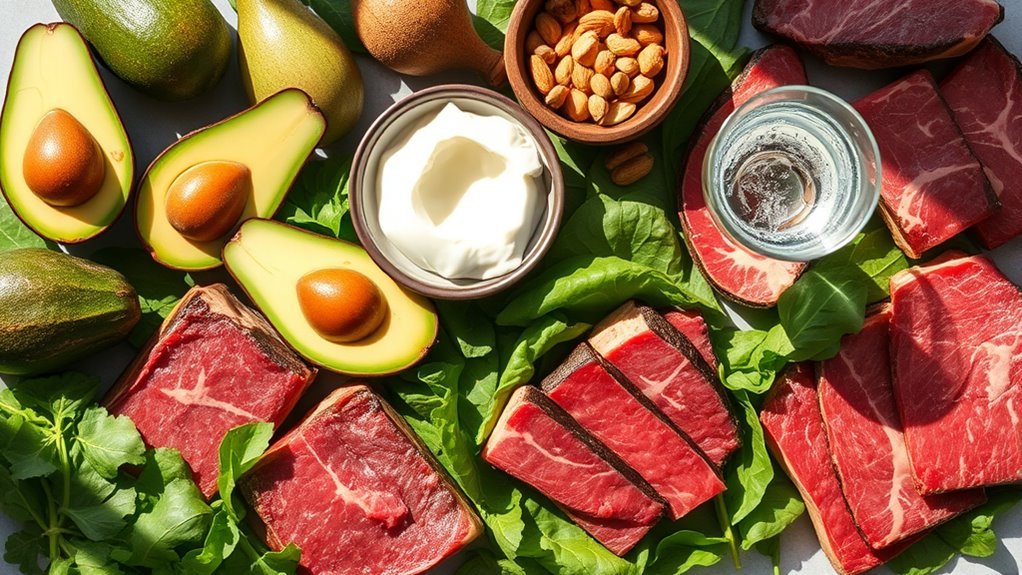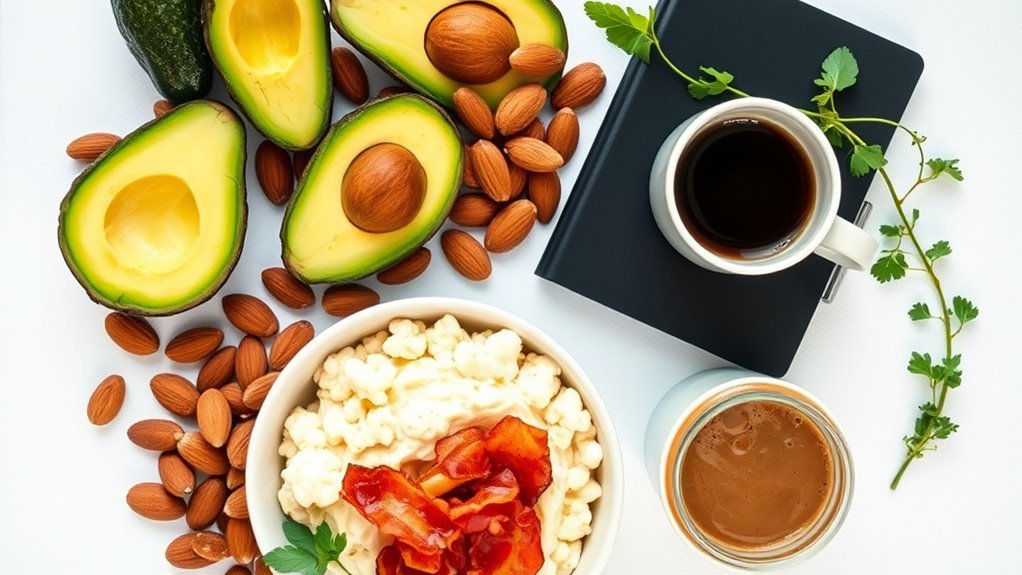To get into ketosis quickly, you need to shift your diet to focus on high fats, reducing carbs to about 5-10% of your total calories. Track your macros to maintain a balance of 70-75% fats and 20-25% protein. Utilize intermittent fasting to boost fat burning, and incorporate exercise like HIIT for quicker results. Stay hydrated and manage your electrolytes to support your body. There’s even more you can do to maximize your keto journey.
Understanding the Ketogenic Diet

When you plunge into the ketogenic diet, you’re fundamentally shifting your body’s primary energy source from carbohydrates to fats. Understanding the keto basics is essential for making effective dietary adjustments. You’ll want to limit your carb intake to about 5-10% of your total calories, increasing fats to around 70-80%, while protein should make up the remaining 20-25%. This change may feel challenging at first, but it’s about teaching your body to burn fat for energy. Focus on whole, unprocessed foods like avocados, nuts, and lean meats, while avoiding sugary snacks and grains. By grasping these fundamental principles, you can take control of your health and enjoy the freedom that comes from a well-structured ketogenic lifestyle.
Benefits of Getting Into Ketosis Quickly

Getting into ketosis quickly offers several benefits, including enhanced fat burning and improved mental clarity. When your body shifts to using fat for fuel, you can experience more efficient weight loss and increased energy levels. Additionally, many people report sharper focus and better cognitive function, making it easier to tackle daily tasks.
Enhanced Fat Burning
Achieving ketosis quickly can greatly enhance fat burning, allowing your body to shift from relying on carbohydrates to utilizing fat as its primary energy source. This change improves fat oxidation, which means your body efficiently breaks down stored fat for energy. When you enter ketosis rapidly, you gain metabolic flexibility, enabling your body to adapt to different energy sources depending on availability. This flexibility can lead to increased energy levels, reduced cravings, and a more efficient metabolism. Plus, by burning fat instead of carbs, you’re tapping into a more sustainable energy source, often resulting in faster weight loss. Embracing this approach provides you with the freedom to enjoy a healthier lifestyle, unburdened by constant carbohydrate dependence.
Improved Mental Clarity
As you shift into ketosis, you’ll likely notice a significant boost in mental clarity. This state enhances your brain energy, leading to improved mental performance and cognitive benefits that can transform your daily life. You may find yourself experiencing:
- Focus enhancement: Concentrate better on tasks without distractions.
- Clarity improvement: Enjoy sharper thinking and decision-making.
- Mood stabilization: Feel more balanced and less prone to mood swings.
- Productivity boost: Accomplish more in less time, thanks to increased mental endurance.
Embracing ketosis can empower you to reclaim your focus and mental agility, providing the freedom to pursue your goals with newfound vigor. With these improvements, you’ll not only think clearer but also feel more motivated and productive.
The Importance of Tracking Macros
Tracking your macros is essential for successfully entering ketosis and maximizing its benefits. By understanding the right macronutrient ratios, you can tailor your meals to stay within your carb limits while ensuring adequate protein and healthy fats. Utilizing effective tools for macro tracking can help you stay accountable and make adjustments as needed for best results.
Understanding Macronutrient Ratios
Understanding macronutrient ratios is vital for anyone looking to shift to a ketogenic diet effectively. By focusing on the right macronutrient distribution, you can achieve ideal ratios that promote fat burning and energy. Here’s what you need to know:
- Fat: Aim for about 70-75% of your daily calories from healthy fats.
- Protein: Keep protein around 20-25%, supporting muscle retention without kicking you out of ketosis.
- Carbohydrates: Limit carbs to 5-10%, ensuring you stay below the threshold that triggers insulin response.
- Hydration: Don’t forget to drink plenty of water; it’s essential for overall well-being on keto.
Tracking these ratios can empower you to stay on course with your goals, giving you the freedom to enjoy your keto journey.
Tools for Macro Tracking
Effective macro tracking is essential for anyone serious about adhering to a ketogenic diet. By using keto apps and macro calculators, you can simplify the process of monitoring your daily intake. These tools help you stay within your targeted macronutrient ratios, ensuring you’re consuming the right amount of fats, proteins, and carbs. Many keto apps also offer features like food databases, recipe suggestions, and barcode scanners, making it easier to log your meals. Plus, they provide visual progress reports, which can be motivating and empowering on your journey. Remember, tracking doesn’t have to feel restrictive; it’s about gaining freedom in understanding your body’s needs and optimizing your health on the keto path.
Choosing the Right Foods for Keto
How can you successfully navigate the myriad of food options while adopting a keto lifestyle? Choosing the right foods is vital for your success. Focus on incorporating:
- Healthy fats: Olive oil, avocados, and nuts.
- Protein sources: Eggs, fish, and grass-fed meats.
- Low carb vegetables: Spinach, broccoli, and zucchini.
- Keto friendly snacks: Cheese sticks or nut butter.
Meal prepping can simplify your grocery shopping and help you stay on track. Don’t forget to explore keto friendly condiments to enhance flavors while maintaining low carb counts. Portion control and meal timing are essential to guarantee you’re fueling your body correctly. If you’re looking for freedom in your diet, these food choices will empower you on your keto journey.
Utilizing Intermittent Fasting
Incorporating intermittent fasting into your keto regimen can further enhance your results by optimizing fat burning and improving metabolic health. This approach allows you to eat within specific time windows, encouraging your body to tap into fat reserves for energy. Popular fasting schedules include the 16/8 method, where you fast for 16 hours and eat during an 8-hour window, or alternate-day fasting. The intermittent fasting benefits extend beyond weight loss; it can also boost insulin sensitivity and reduce inflammation. By aligning your fasting schedule with your lifestyle, you gain flexibility and freedom while still achieving your keto goals. Experiment with different strategies to find what fits best, and enjoy the enhanced health and liveliness that come with this powerful combination.
Increasing Healthy Fats in Your Diet
While many people associate a healthy diet with low fat, increasing healthy fats is essential for successfully following a keto lifestyle. Embracing healthy fat sources helps your body enter ketosis, where it burns fat for energy instead of carbs. Here are some practical ways to boost healthy fats in your diet:
Increasing healthy fats is key to a successful keto lifestyle, helping your body burn fat for energy.
- Avocados and avocado oil
- Nuts and seeds, like almonds and chia seeds
- Fatty fish, such as salmon and mackerel
- Coconut oil and grass-fed butter
Experiment with different cooking techniques, like sautéing vegetables in coconut oil or drizzling olive oil on salads. By incorporating these healthy fats, you’ll not only enhance flavor but also nourish your body, giving you the freedom to thrive on your keto journey.
Reducing Carbohydrate Intake Effectively
To effectively embrace a keto lifestyle, reducing carbohydrate intake is a key step. Start by identifying high-carb foods in your diet and replacing them with low-carb options. Consider implementing carb cycling, where you alternate between high and low-carb days, allowing flexibility while keeping your body in ketosis. This method can help you manage cravings and provide energy for workouts. Additionally, don’t forget about sugar substitutes like stevia or erythritol that can sweeten your meals without the carbs. They’re perfect for satisfying your sweet tooth while staying on track. Remember, it’s all about finding what works best for you, maintaining balance, and enjoying the freedom that comes with a low-carb lifestyle.
Incorporating Exercise for Faster Results
Incorporating exercise into your keto journey can greatly accelerate your results. Focus on effective workouts like high-intensity interval training (HIIT) or strength training, which can enhance fat burning and boost metabolism. Timing your exercise sessions around your meals may also optimize your energy levels and improve overall performance.
Types of Effective Workouts
Engaging in effective workouts can markedly enhance your journey into ketosis and accelerate weight loss. By incorporating various exercise types, you can keep your routine fresh and enjoyable. Here are some effective workouts to evaluate:
- High Intensity Interval Training (HIIT): Burns calories quickly and boosts metabolism.
- Strength Training Techniques: Builds muscle and supports fat loss through resistance training.
- Cardio Workouts: Improves heart health and aids in burning fat.
- Yoga Benefits: Increases flexibility and reduces stress, supporting overall wellness.
Whether you prefer group classes, circuit training, outdoor activities, or home workouts, find what resonates with you. Mixing different styles will not only enhance your results but also maintain your motivation on this liberating path to ketosis.
Timing Your Exercise Sessions
Timing your exercise sessions can greatly impact your ability to reach ketosis more efficiently. To maximize your results, focus on workout timing that aligns with your body’s natural rhythms. Studies suggest exercising in a fasted state can enhance fat oxidation, pushing you deeper into ketosis. Aim for a mix of high-intensity workouts and moderate exercise frequency throughout the week to keep your metabolism revved up. Consider incorporating strength training sessions post-carb intake for ideal glycogen depletion, which can expedite your shift to burning fat. Ultimately, listen to your body and adjust your schedule as needed. By strategically timing your workouts, you’ll not only feel empowered but also accelerate your keto journey, enjoying the freedom that comes with a healthy lifestyle.
Staying Hydrated and Managing Electrolytes
While you’re adapting to a ketogenic diet, staying hydrated and managing your electrolytes becomes essential to your overall success and well-being. Proper hydration strategies can help you avoid the dreaded “keto flu” and maintain energy levels. Focus on your electrolyte balance by incorporating these tips:
Staying hydrated and maintaining electrolyte balance is crucial for success on a ketogenic diet, helping you avoid the “keto flu.”
- Drink plenty of water throughout the day.
- Add a pinch of salt to your meals to boost sodium intake.
- Consider magnesium and potassium-rich foods, like avocados and leafy greens.
- Use electrolyte supplements if needed, especially during the initial change.
Common Mistakes to Avoid on Your Keto Journey
As you commence your keto journey, it’s crucial to recognize and avoid common pitfalls that can hinder your progress. One major mistake is not tracking your carb intake. Even small amounts of hidden sugars can derail your efforts. Focus on avoiding sugar completely and read labels carefully. Another common pitfall is neglecting healthy fats. While keto thrives on fats, opting for unhealthy sources can lead to inflammation and weight gain. Additionally, don’t underestimate the importance of meal prep; it helps you stick to your plan and avoid temptations. Finally, be cautious with low-carb snacks; they can still pack in carbs. By steering clear of these missteps, you can maximize your freedom and success on the keto path.


